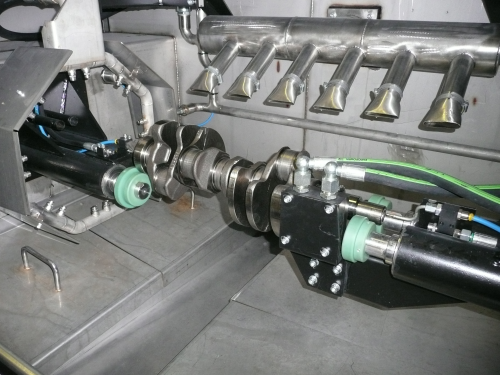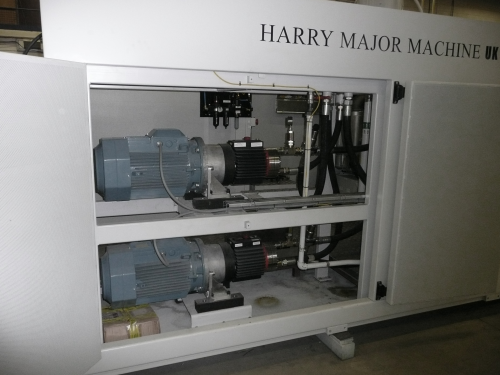

A UK-built purpose-designed wash unit for cleaning crankshafts on the production line of a Mexican engine plant embodies a new approach to the fast removal of carbon deposits from heat treated components during manufacture.
One of a suite of washers to be built by Harry Major Machine (HMM-UK), under a contract awarded by a leading car manufacturer, the new unit is already on site following full-scale pre-delivery trials at the company’s facility at Sandy, Bedfordshire. The design concept aims to combine high levels of performance with reduced running costs.
Chemical wash jets at up to 170 bar pressure replace established procedures that rely on costly arbor-mounted nylon brushes needing CNC controlled readjustment and frequent replacement. Operational costs have also been held down in the energy-efficient low-maintenance high-pressure pumping system, which utilises two Hydra-Cell G15 pumps manufactured by Wanner Engineering. The seal-less design of these pumps avoids the need for the expensive ultra-fine filtration required by other high pressure pumps to protect dynamic seals.
As part of the crankshaft production process at the Mexican plant, gear teeth are heat treated and dipped out in oil, leaving carbon residues that would attract dirt in the engine compartment of a vehicle.
On a production line working 24/7, a new crankshaft arrives at the cleaning station every 55 seconds – little time to shift carbon deposits. Conventionally, a cleaning task of this order is a mechanical operation performed with nylon filament brushes, mounted in an arbor and position-adjusted under CNC control to compensate for wear. But even with very fine adjustment, for example indexing closer on every 500 parts, there is still an element of inconsistency. Part number 1000 may not be cleaned exactly as part number one. The system must work within tolerances, but there is a risk of over or under compensating for brush wear.
These problems, added to the purchase and disposal costs of the brushes, encouraged HMM-UK in close consultation with the customer, to develop an alternative solution. High pressure liquid jets had potential, but the company was wary of the limitations of many high pressure pumps in terms of their filtration requirements and their susceptibility to problems of seal wear and replacement when pumping recycled chemical solutions at high pressure.
For this project and other systems involving high pressure cleaning, HMM-UK was on the lookout for a pump that could handle recycled water which might contain small particles. At a trade show in Hannover, MD Mervyn Gillespie saw a demonstration that caught his eye. On the Wanner International exhibit a Hydra-Cell pump was pumping water with a generous suspension of sand!
A few months later, a series of tests were arranged at Wanner’s European HQ in the presence of HMM-UK and an engineer from the Mexican engine plant. Experiments with various shafts, a variety of spray nozzles, and pumps capable of 80 bar to 170 bar pressure validated the concept, showing clearly that high pressure jets could effectively remove carbon deposits from the shafts.
The system in the cleaning machine delivered to Mexico employs two 170 bar G15 pumps feeding twelve spray nozzles via a common manifold. The jets are directed to concentrate impact on the critical areas of gear teeth and diameter root.
Mervyn Gillespie cites a number of significant advantages for the jet cleaning concept and the adoption of Hydra-Cell seal-less pump technology for the high pressure delivery system.
“By using jets, which are non-contact and non-intrusive, we have simplified the cleaning operation and set aside the whole paraphernalia of mechanical brushing, which is tricky to control and not entirely consistent in its results. We have also reduced the customer’s future operating costs by dispensing with brush replacement and disposal.
“In the Hydra-Cell pump, we have a unit of simple and reliable design which can handle chemicals and particulates and deliver the high pressure we need on this particular cleaning application. We have also identified a number of other applications that also need high pressure jetting, although they may only require 70-80 bar, well within the range of most Hydra-Cell models, but with the ability to vary pressure and volume flow with the aid of a simple inverter and pressure by-pass valve, we are looking at further opportunities to exploit the special features of their design.”
One advantage of seal-less design in cleaning applications is that the pumps can handle fluids at temperatures up to 120ºC, making it possible to reduce chemical usage.
Mervyn Gillespie added: “Having no dynamic seals, these pumps do not need the staged fine filtration manufacturers of piston pumps usually specify, often down to 5 or 10 micron. On this present project, the process itself needs only a single stage 50 micron filtration unit. Using traditional piston pumps would add substantially to both purchase and running costs.
“Overall on this project we are targeting a tooling and maintenance expenditure close to zero.”






